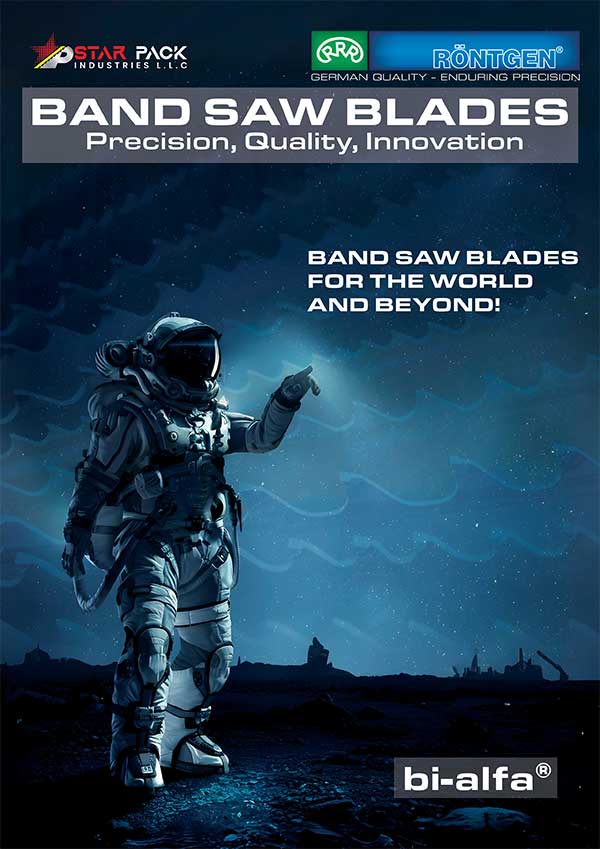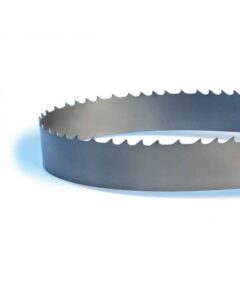Industrial Bandsaw Blades
Our range of Rontgen bandsaw blades is engineered for precision and durability in demanding cutting applications. Designed using advanced M42 high‐speed steel and innovative bi‐metal construction, these blades deliver superior performance whether you’re contour cutting, sawing tubes and profiles, or handling heavy-duty production tasks. The patented tooth geometry—including features like variable rake angles and anti-tooth stripping designs—ensures excellent chip clearance, reduced vibration, and a smoother cut, which minimises downtime and optimises tool life.
Ideal for a wide array of materials—from mild and tool steels to stainless, aluminium, and even plastics—our Bahco blades are tailored for applications in fabrication, maintenance, and industrial machining. They provide the precision required in tool rooms and welding shops, as well as the robustness necessary for foundry and high-production environments. With options that include carbide-tipped variants for abrasive materials and standard bi-metal blades for versatile use, our selection helps you achieve consistent, efficient cuts and high-quality surface finishes.
Explore our technical range to find the optimal bandsaw blade solution that meets your specific cutting requirements, enhances productivity, and reduces overall operational costs.
Bandsaw Blades for Cutting Metal – Choosing the best one
- Why blade material matters: matching blade type to workpiece hardness, volume, finish and cost-per-cut./li>
- Bi-Metal blades: how high-speed steel teeth welded to a flexible steel back deliver long life, clean cuts and versatility.
- Carbide-tipped blades: why tungsten-carbide teeth excel on hardened and abrasive alloys.
- Selection & maintenance best practices: feed rates, lubrication, tensioning and tooth pitch tips to maximize blade life and cut quality.
Selecting the wrong blade can dramatically increase cutting time, wear, and cost per cut. Softer carbon steel blades wear out quickly on hard metals, whereas purpose-built bi-metal and carbide blades offer the hardness, toughness and heat resistance needed for most ferrous and non-ferrous applications. In production or foundry settings, cost per cut and downtime for blade changes are critical; premium blades often pay for themselves through extended life and fewer secondary operations.
Bi-Metal
Bi-metal blades combine a high-speed steel (HSS) cutting edge with a flexible alloy-steel backing, merging hardness and toughness in one blade.
Key features & benefits
- HSS tooth edge: Maintains sharpness and resists heat up to ~600 °C, for clean cuts in stainless, tool steels and high-volume work.
- Flexible backing: Absorbs bending stress around drive wheels, preventing premature breakage.
- Versatility: Ideal across round bars, tubing, profiles and complex contours, from mild steel to mid-hard alloys.
- Cost-effectiveness: Longer life than carbon-steel blades and lower cost-per-cut than carbide in general-purpose cutting.

Best practices for Bi-Metal blade use
- Tooth pitch selection: Use coarse pitch (e.g. 2 TPI) on large section cuts; finer pitch (8–14 TPI) on thin or hard materials.
- Lubrication & cooling: Always flood the cut zone with cutting fluid to reduce heat and extend tooth life.
- Proper tensioning: Follow machine manufacturer’s specs; under-tensioning leads to tracking issues, over-tensioning to breakage.
- Feed rate control: Match feed to blade width and TPI—too aggressive leads to tooth stripping, too light to rubbing and heating.

Bi Metal Bandsaw Blade Designed for long life and general purpose cutting applications.
Suitable for most general engineering workshops.
Advantage
EXCEPTIONAL BLADE LIFE
Proprietary backing steel preparation increases fatigue life and minimizes band breaks.
EXTREMELY VERSATILE
Cuts a wide range of metals from low carbon steels to higher strength alloys. Advanced design enables production cutting of solids and structurals. Positive rake angle improves tooth penetration on saws with limited feed force.


